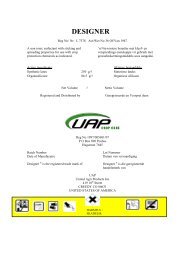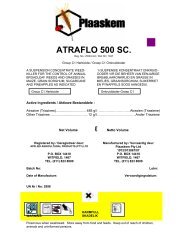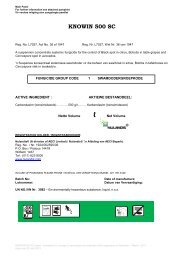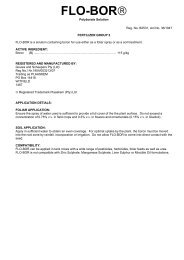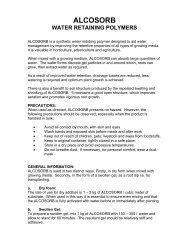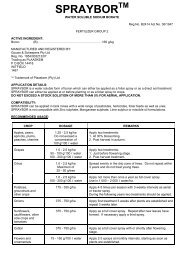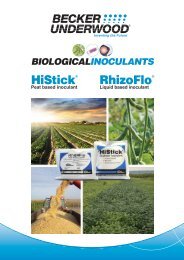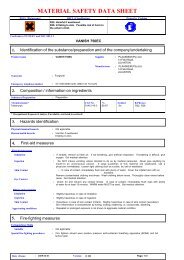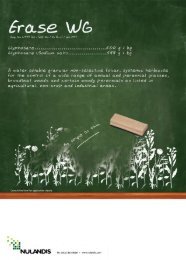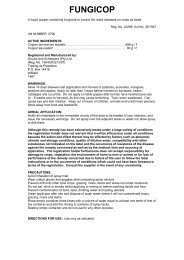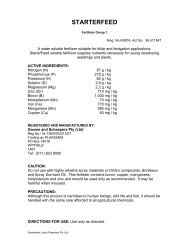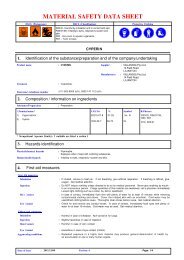cyperin 200 ec - Nulandis
cyperin 200 ec - Nulandis
cyperin 200 ec - Nulandis
You also want an ePaper? Increase the reach of your titles
YUMPU automatically turns print PDFs into web optimized ePapers that Google loves.
For further information see attached pamphlet<br />
Vir verdere inligting sien aanghegte pamflet<br />
Main Panel<br />
CYPERIN <strong>200</strong> EC<br />
Reg No./Nr. L5321, Act No./ Wet Nr. 36 of/van 1947<br />
Malawi Reg. No. MW/PCB/2011/0363<br />
Namibian Reg. No. N-AR 1201/ Namibiese Reg. Nr. N-AR 1201<br />
An emulsifiable concentrate, contact and<br />
stomach ins<strong>ec</strong>ticide for the control of<br />
various ins<strong>ec</strong>t pests on crops as indicated.<br />
INSECTICIDE GROUP CODE 3A<br />
‘n Emulgeerbare konsentraat<br />
kontak- en maaginsekdoder<br />
vir die beheer van verskeie<br />
insekplae op gewasse soos<br />
aangedui.<br />
INSEKDODERGROEPKODE<br />
ACTIVE INGREDIENT:<br />
AKTIEWE BESTANDDEEL:<br />
Cypermethrin ........................................ <strong>200</strong> g/l ................................Sipermetrien<br />
(Pyrethroid)<br />
(Piretroïed)<br />
Net Volume l Netto Volume<br />
REGISTRATION HOLDER / REGISTRASIEHOUER:<br />
<strong>Nulandis</strong> (A division of AECI Limited)/ <strong>Nulandis</strong> (‘n Afdeling van AECI Beperk)<br />
Reg. No. / Nr. 1924/002590/06<br />
P.O. Box / Posbus 14418<br />
Witfield, 1467<br />
Tel : (011) 823 8000<br />
IN CASE OF POISONING PLEASE PHONE / IN GEVAL VAN VERGIFTIGING SKAKEL (021) 931-6129<br />
BATCH NO / LOTNOMMER:<br />
DATE OF MANUFACTURE / DATUM VAN VERVAARDIGING:<br />
UN NUMBER: 3351 – Pyrethroid pesticide, liquid, toxic flammable<br />
YELLOW BAND<br />
.<br />
HARMFUL<br />
SKADELIK<br />
1<br />
Label submitted June 2012 – Approved 12.3.2013
PAMPHLET<br />
CYPERIN <strong>200</strong> EC<br />
Reg No. L5321, Act No. 36 of 1947<br />
Malawi Reg. No. MW/PCB/2011/0363<br />
Namibian Reg. No. N-AR 1201<br />
An emulsifiable concentrate, contact and stomach ins<strong>ec</strong>ticide for the control of various ins<strong>ec</strong>t<br />
pests on crops as indicated.<br />
ACTIVE INGREDIENT:<br />
Cypermethrin (pyrethroid)<br />
REGISTRATION HOLDER :<br />
<strong>Nulandis</strong> (A Division of AECI Limited)<br />
Reg. No. 1924/002590/06<br />
P.O. Box 14418<br />
Witfield, 1467<br />
Tel : (011) 823 8000<br />
INSECTICIDE GROUP CODE 3A<br />
<strong>200</strong> g/l<br />
HARMFUL<br />
WARNINGS:<br />
ALLOW THE FOLLOWING WITHHOLDING PERIODS (MINIMUM NUMBER OF DAYS)<br />
FROM LAST APPLICATION AND HARVESTING OR GRAZING;<br />
CROP<br />
DAYS<br />
PEACHES (CANNING) 3<br />
BEANS ; GROUNDNUTS (HAY); PEAS 7<br />
COTTON (GRAZING); SORGHUM; GRAPES (TABLE AND WINE) 28<br />
CRUCIFERAE; TOMATOES 4<br />
LUCERNE; MAIZE; PEACHES; SWEETCORN; APPLES; PEARS; 14<br />
PLUMS; PASTURES<br />
MACADAMIAS 30<br />
Handle with care. Poisonous if inhaled, swallowed or absorbed through the skin. May cause<br />
irritation to skin, eyes and respiratory system.<br />
Toxic to fish, bees and wildlife.<br />
Flammable – Do not store or spray near open flame. Keep out of reach of children and<br />
uninformed person and animals.<br />
Store in a cool dry place, away from food and feed.<br />
If soil is dry, do not apply for cutworm control.<br />
Re-entry: Do not enter treated area within 1 day after treatment unless wearing prot<strong>ec</strong>tive<br />
clothing.<br />
In case of poisoning, CALL A DOCTOR AND MAKE THIS LABEL AVAILABLE TO HIM.<br />
Aerial application - notify all inhabitants of the immediate area to be sprayed and issue the<br />
n<strong>ec</strong>essary warnings. Do not spray over or allow drift to contaminate water or adjacent areas.<br />
ALTHOUGH THIS REMEDY HAS BEEN EXTENSIVELY TESTED UNDER A LARGE<br />
VARIETY OF CONDITIONS THE REGISTRATION HOLDER DOES NOT WARRANT THAT<br />
IT WILL BE EFFICACIOUS UNDER ALL CONDITIONS BECAUSE THE ACTION AND<br />
EFFECT THEREOF MAY BE AFFECTED BY FACTORS SUCH AS ABNORMAL SOIL,<br />
CLIMATIC AND STORAGE CONDITIONS, QUALITY OF DILUTION WATER,<br />
COMPATIBILITY WITH OTHER SUBSTANCES NOT INDICATED ON THE LABEL AND<br />
THE OCCURRENCE OF RESISTANCE OF THE PESTS TO THE REMEDY CONCERNED<br />
AS WELL AS BY THE METHOD, TIME AND ACCURACY OF APPLICATION. THE<br />
REGISTRATION HOLDER FURTHERMORE DOES NOT ACCEPT RESPONSIBILITY FOR<br />
DAMAGE TO CROPS, VEGETATION, THE ENVIRONMENT OR HARM TO MAN OR<br />
ANIMAL OR FOR LACK OF PERFORMANCE OF THE REMEDY CONCERNED DUE TO<br />
FAILURE OF THE USER TO FOLLOW THE LABEL INSTRUCTIONS OR TO THE<br />
OCCURRENCE OF CONDITIONS WHICH COULD NOT HAVE BEEN FORESEEN IN<br />
TERMS OF THE REGISTRATION. CONSULT THE SUPPLIER IN THE EVENT OF ANY<br />
UNCERTAINTY.<br />
2<br />
Label submitted June 2012 – Approved 12.3.2013
PRECAUTIONS:<br />
Avoid inhalation, skin and eye contact, of the spray mist.<br />
Wear prot<strong>ec</strong>tive clothing (faceshield, rubber gloves and boots) when handling the<br />
concentrate.<br />
Wash with soap and water after use or accidental skin contact.<br />
Do not eat, drink or smoke whilst mixing or applying, or before washing hands and face and<br />
changing clothes.<br />
Prevent contamination of food, drinking water, feed and eating utensils.<br />
Prevent spray drift onto other crops, grazing, rivers, dams and areas not under treatment.<br />
Clean applicator thoroughly with FLUSHSOL before re-using and dispose of wash water<br />
where it will not contaminate crops, grazing, rivers dams or boreholes. Refer to the<br />
FLUSHSOL label for dir<strong>ec</strong>tions of use.<br />
When empty, invert the container over the spray tank or mixing tank and allow it to drain for at<br />
least 30 s<strong>ec</strong>onds after the flow has slowed down to a drip. Thereafter rinse the container<br />
three times with a volume of water equal to at least one tenth of that of the container and add<br />
the rinsings to the contents of the spray tank. Destroy the container in the prescribed<br />
manner. Destroy empty container by perforation, flattening or burning. Do not re-use for any<br />
other purpose.<br />
SYMPTOMS OF POISONING:<br />
No known symptoms<br />
FIRST AID TREATMENT:<br />
Always obtain treatment by a doctor immediately.<br />
If inhaled: Remove patient to fresh air. If not breathing, give artificial respiration. If breathing<br />
is difficult, give oxygen. Get medical attention.<br />
If ingested: DO NOT INDUCE vomiting unless dir<strong>ec</strong>ted to do so by medical personnel. Never<br />
give anything by mouth to an unconscious person. If large quantities of this material are<br />
swallowed, call a physician immediately. Loosen tight clothing such as a collar, tie, belt or<br />
waistband.<br />
Skin contact: In case of contact, immediately flush with plenty of water for at least 15 minutes<br />
while removing contaminated clothing and shoes. Cover the irritated skin with an emollient.<br />
Cold water may be used. Wash clothing before re-use. Thoroughly clean shoes before reuse.<br />
Get medical attention.<br />
Eye contact: Ch<strong>ec</strong>k for and remove any contact lenses. In case of contact, immediately flush<br />
eyes with plenty of water for at least 15 minutes. Cold water may be used. Get medical<br />
attention.<br />
NOTE TO PHYSICIAN:<br />
No sp<strong>ec</strong>ific antidote – Treat symptomatically<br />
RESISTANCE WARNING:<br />
For resistance management, Cyperin <strong>200</strong> EC is a group 3A ins<strong>ec</strong>ticide. Any ins<strong>ec</strong>t population<br />
may contain individuals naturally resistant to Cyperin <strong>200</strong> EC and other group 3A<br />
ins<strong>ec</strong>ticides. The resistant individuals dominate the ins<strong>ec</strong>t population if these ins<strong>ec</strong>ticides are<br />
used repeatedly. These resistant ins<strong>ec</strong>ts may not be controlled by Cyperin <strong>200</strong> EC or other<br />
group 3A ins<strong>ec</strong>ticides, although local experts should be consulted for local resistance<br />
r<strong>ec</strong>ommendations. The following classification scheme is based on mode of action. It is<br />
r<strong>ec</strong>ognized that resistance of ins<strong>ec</strong>ts and mites to ins<strong>ec</strong>ticides and acaricides can also result<br />
from enhanced metabolism, reduced penetration or behavioural changes that are not linked to<br />
any site of action classification but are sp<strong>ec</strong>ific for individual chemicals or chemical groupings.<br />
Despite of this, alternation of compounds from different chemical classes remains a viable<br />
management t<strong>ec</strong>hnique. To delay ins<strong>ec</strong>ticide resistance:<br />
*Avoid exclusive repeated use of ins<strong>ec</strong>ticides from the same chemical subgroup.<br />
*Integrate other control methods (chemical, cultural, biological) into ins<strong>ec</strong>t control<br />
programmes<br />
For further information contact the registration holder of this product.<br />
3<br />
Label submitted June 2012 – Approved 12.3.2013
American bollworm resistance management:<br />
Resistance of American bollworm (Helicoverpa armigera) to synthetic pyrethroids has been<br />
confirmed.<br />
COTTON: Synthetic pyrethroids must only be applied to cotton during the period 1 January to<br />
28 February. DO NOT apply more than two applications per growing season.<br />
ALL OTHER CROPS: If a pyrethroid gives poor performance DO NOT re-spray with any<br />
synthetic pyrethroid, even at a corr<strong>ec</strong>tive dosage rate. Use a product from a different<br />
chemical group code.<br />
DIRECTIONS FOR USE: USE ONLY AS DIRECTED<br />
COMPATIBILITY:<br />
Do not mix with seaweed extract or amitraz, chinomethionat, vamidothion, prothiophos.<br />
When spraying apples, pears and grapes a wetting agent should not be added to<br />
Cyperin <strong>200</strong> EC.<br />
Cyperin <strong>200</strong> EC is compatible with most cotton miticides in common use. The compatibility<br />
of Cyperin <strong>200</strong> EC with other products may be influenced by the formulation of the products<br />
involved as well as the quality of the water. Since the formulation of other products may<br />
change and water quality may vary from farm to farm a physical compatibility test should<br />
always be carried out prior to application.<br />
MIXING INSTRUCTIONS:<br />
The addition of Bladbuff 7 (Reg. No. L8121, Act No. 36 of 1947) or Bladbuff 12 (Reg. No.<br />
L8201, Act No. 36 of 1947) to the spray water prior to adding Cyperin <strong>200</strong> EC, is<br />
r<strong>ec</strong>ommended to prevent alkaline hydrolysis. Add Bladbuff 7 or Bladbuff 12 first to the<br />
spray water. For optimum stability, Cyperin <strong>200</strong> EC should be applied at a pH of 3-4.<br />
Half fill the spray tank with clean water. Add the measured amount of Cyperin <strong>200</strong> EC to the<br />
tank while agitating. Fill the tank and maintain agitation until spraying is completed. Ensure<br />
thorough agitation during the filling of the spray tank and spraying. Prepared spray mixture<br />
must not be left in the spray tank for any length of time e.g., overnight.<br />
GROUND APPLICATION:<br />
When using a conventional high volume sprayer or a mist blower, fit equipment with hollow<br />
cone nozzles that provides medium to fine droplets. Ensure that sprayers are calibrated<br />
before spraying and that thorough coverage is obtained. An uniform distribution must be<br />
ensured throughout the target area. The use of drop arms on conventional booms are<br />
r<strong>ec</strong>ommended when spraying crops such as cotton and tomatoes. Do not spray plants that<br />
are wet with dew or rain.<br />
AERIAL APPLICATION:<br />
Aerial application may only be done by a registered aerial application operator using a<br />
corr<strong>ec</strong>tly calibrated, registered aircraft according to the instructions of SANS Code 10118<br />
(Aerial Application of Agricultural Pesticides). It is important to ensure that the spray mixture<br />
is distributed evenly over the target area and that the loss of spray material during application<br />
is restricted to a minimum. It is therefore essential that the following criteria are met:<br />
Equipment:<br />
q<br />
q<br />
q<br />
Use suitable atomising equipment (hydraulic nozzles or rotary atomisers) that will produce<br />
the desired droplet size and coverage, but which will ensure the minimum loss of product<br />
through drift.<br />
The operator must use a setup that will produce a droplet sp<strong>ec</strong>trum with the lowest<br />
possible relative span.<br />
All nozzles / atomisers should be positioned within the inner 75 % of the wingspan to<br />
prevent droplets from entering the wingtip vortices.<br />
4<br />
Label submitted June 2012 – Approved 12.3.2013
Application parameters:<br />
q<br />
q<br />
q<br />
q<br />
q<br />
A minimum volume of 30 l spray mixture per h<strong>ec</strong>tare is r<strong>ec</strong>ommended. As this product<br />
has not been evaluated at a reduced volume rate, the registration holder cannot<br />
guarantee efficacy, or be held responsible for any adverse eff<strong>ec</strong>ts if this product is applied<br />
aerially at a lower volume rate than r<strong>ec</strong>ommended above.<br />
A droplet coverage of 30-40 droplets per cm 2 must be r<strong>ec</strong>overed at the target.<br />
A droplet sp<strong>ec</strong>trum with a VMD (Volume Median Diameter) of 250-280 microns is<br />
r<strong>ec</strong>ommended. Ensure that the production of fine droplets (smaller than 150 microns) is<br />
restricted to a minimum.<br />
The height of the spray boom should be maintained at 3-4 metres above the target. Do<br />
not spray when aircraft is in a climb, at the top or during a dive, or when banking.<br />
Apply before the crop b<strong>ec</strong>omes too dense, thus preventing proper coverage of the plants.<br />
Meteorological conditions:<br />
q<br />
q<br />
q<br />
q<br />
The difference between the wet and dry bulb readings as determined by a whirling<br />
hygrometer, must not exceed 8 °C.<br />
Do not spray under turbulent, unstable conditions during the heat of the day when rising<br />
thermals and downdraughts occur.<br />
Do not spray under temperature inversion conditions (spraying in or above the inversion<br />
layer).<br />
Do not spray if the wind speed exceeds 15 km/h.<br />
General:<br />
q<br />
q<br />
Ensure that fields are accurately marked and that the aerial spray operator knows exactly<br />
which fields to spray.<br />
Obtain an assurance from the aerial spray operator that the above requirements will be<br />
met.<br />
5<br />
Label submitted June 2012 – Approved 12.3.2013
APPLICATION TABLE:<br />
CROP / PEST DOSAGE REMARKS<br />
ALL CROPS<br />
Cutworms<br />
APPLES & PEARS<br />
Codling moth, Leaf roller,<br />
American bollworm<br />
Ground Application:<br />
100 ml/ha<br />
0.33 ml/100 m plant row<br />
Aerial Application:<br />
100 ml/ha<br />
5 ml/100 l water<br />
High volume<br />
(125 – 175 ml/ha)<br />
Low volume<br />
(100 – 140 ml/ha )<br />
Apply treatment either pre or post emergence when<br />
pests are noticed. Ensure that the top 3 cm of the soil<br />
is moist. Repeat treatment in case of re-infestation.<br />
1. Overall spray<br />
Apply in 300 l water/ha.<br />
2. Band spray (300 mm wide)<br />
Apply in at least 3 l water/100m row.<br />
Apply in 30 l water/ha.<br />
NB: Refer to “Warning against American bollworm<br />
resistance” under “Resistance Warning”.<br />
Apply first spray at 75 % petal drop and repeat at 14<br />
day intervals.<br />
Apply as a corr<strong>ec</strong>tive treatment not earlier than 75 %<br />
petal drop.<br />
Use 2 500 – 3 500 l spray mixture per ha.<br />
Caution:<br />
Toxic to bees.<br />
Banded fruit weevil<br />
(Snout beetle)<br />
BEANS<br />
American bollworm<br />
10 ml/100 l water<br />
High volume<br />
(250 – 350 ml/ha)<br />
Low volume<br />
(<strong>200</strong> – 280 ml/ha)<br />
150 ml/ha<br />
High Volume Application<br />
Using 2 500 – 3 500 l spray mixture per ha. Apply<br />
two sprays, the first at 75 % petal drop. Repeat 4<br />
weeks later. Further, either a low or high volume<br />
spray can be applied during mid-January to prevent<br />
late season damage.<br />
Low Volume Application<br />
Using ¼ or 1/8 of spray volume indicated for high<br />
volume application.<br />
NB: Refer to “Warning against American bollworm<br />
resistance” under “Resistance Warning”.<br />
Ground Application: Apply in 300 l water. Insp<strong>ec</strong>t<br />
lands regularly and if n<strong>ec</strong>essary repeat application.<br />
Apply as soon as eggs or larvae are noticed<br />
Aerial Application: Apply in 30 l water/ha.<br />
6<br />
Label submitted June 2012 – Approved 12.3.2013
CROP / PEST DOSAGE REMARKS<br />
COTTON<br />
American, Red & spiny<br />
bollworm, stainers & Semilooper<br />
(Plusia)<br />
7-day Spray programme<br />
NB: Refer to “Warning against American bollworm<br />
resistance” under “Resistance Warning”.<br />
Cyperin <strong>200</strong> EC is primarily r<strong>ec</strong>ommended for use as<br />
a preventative control measure against all bollworm<br />
larvae during the period of fruiting, i.e., from peak<br />
flowering until boll split (approximately 10 – 22 weeks<br />
after plant emergence). Treatment is based on<br />
regular scouting or a regular spray programme.<br />
Cyperin <strong>200</strong> EC may also be used corr<strong>ec</strong>tively<br />
against bollworm larvae and leaf eaters if these are<br />
found during scouting. A bollworm spray programme<br />
will normally commence at the beginning of flowering<br />
but to ensure proper pest management Cyperin <strong>200</strong><br />
EC should not be used from this period until peak<br />
flowering (10 – 12 weeks after plant emergence).<br />
During this period use profenofos for the control of<br />
American bollworm. Apply sufficient spray mixture to<br />
ensure good coverage of the plants.<br />
Ground Application:<br />
75 ml/100 l water<br />
Ground Application: Apply <strong>200</strong> l mixture/ha.<br />
Aerial Application: Aerial Application: Apply in 30 l water/ha.<br />
175 ml/ha<br />
NOTES:<br />
1. Apply Cyperin <strong>200</strong> EC from week 12 when the following larvae and / or egg infestation levels are reached.<br />
American bollworm: 2 larvae or 12 eggs on 24 plants.<br />
Red bollworm: 2 larvae or 6 eggs on 24 plants.<br />
Spiny bollworm: 2 larvae<br />
2. A set programme, at 7-day intervals may be followed.<br />
3. Half the rate r<strong>ec</strong>ommended above may be applied to cotton 600 mm and smaller i.e. 100 l spray mixture/ha in<br />
the case of ground application.<br />
4. In case of high infestation – more than 2 bollworm larvae per 24 plants, it is advisable to increase the dosage<br />
amount.<br />
CRUCIFERAE<br />
American bollworm,<br />
Diamond-back moth larvae,<br />
Thrips<br />
10 ml/100 l water<br />
NB: Refer to “Warning against American bollworm<br />
resistance” under “Resistance Warning”.<br />
Ensure good wetting of the plant.<br />
At first signs of pest commence spraying. Repeat 10-<br />
14 days later if n<strong>ec</strong>essary.<br />
FORESTRY<br />
Pine emperor moth larvae<br />
--------------------------------<br />
Willow tree emperor moth<br />
larvae<br />
----------------------------------<br />
Wattle bagworm<br />
Aerial Application:<br />
50 ml/ha<br />
---------------------------------<br />
Aerial Application:<br />
100 ml/ha<br />
---------------------------------<br />
Aerial Application:<br />
100 ml/ha<br />
Apply in 30 l water/ha.<br />
---------------------------------------------------------------------<br />
Apply in 30 l water/ha.<br />
---------------------------------------------------------------------<br />
Apply in 30 l water/ha. Commence spraying during<br />
November / D<strong>ec</strong>ember.<br />
7<br />
Label submitted June 2012 – Approved 12.3.2013
CROP / PEST DOSAGE REMARKS<br />
GROUNDNUTS<br />
American bollworm<br />
150 ml/ha<br />
NB: Refer to “Warning against American bollworm<br />
resistance” under “Resistance Warning”.<br />
Ground Application: Apply in 250 l water/ha.<br />
Aerial Application: Apply in 30 l water/ha. Commence<br />
spraying as soon as eggs or larvae are noticed.<br />
Repeat if n<strong>ec</strong>essary.<br />
LUCERNE<br />
Lucerne caterpillar<br />
Ground Application:<br />
75 ml/ha<br />
Apply as full cover spray in 300 l water/ha as soon as<br />
pest is noticed. Good coverage and wetting is<br />
essential.<br />
MACADAMIAS<br />
Stinkbugs<br />
MAIZE AND SWEET<br />
CORN<br />
American bollworm<br />
20 ml/100 l water Commence spraying when nuts are marble size.<br />
Repeat after 4 weeks. If n<strong>ec</strong>essary another spray 4<br />
weeks later can be applied, but not later than 30 days<br />
before harvest.<br />
NB: Refer to “Warning against American bollworm<br />
resistance” under “Resistance Warning”.<br />
----------------------------------<br />
Stalk borer<br />
PASTURES<br />
Army worm<br />
Aerial Application:<br />
150 ml/ha<br />
Ground Application:<br />
1,5 ml/100 m row<br />
---------------------------------------<br />
Ground Application:<br />
3,5 ml/100 m row<br />
Aerial Application:<br />
350 ml/ha<br />
150 ml/ha<br />
Apply in 30 l water/ha. Ensure timeous application,<br />
i.e. before larvae enter tassel and not later than 80%<br />
tassel emergence. Only larvae which come in contact<br />
with product will be controlled.<br />
Use in not less than 3 l water/100 m row – ensure<br />
that nozzles are dir<strong>ec</strong>ted towards the cob.<br />
-----------------------------------------------------------------------<br />
Apply 7-10 days after 5 % or more plants are infested<br />
with eggs. Larvae in the stalk or bigger than 10 mm<br />
will not be controlled. S<strong>ec</strong>ond spray could be<br />
n<strong>ec</strong>essary if infestation is over a long period.<br />
Do not apply in less than 3 l water/100 m row. To<br />
ensure good coverage inside the funnel as well as on<br />
the sides of the plant, use at least two D4/35 or D5/35<br />
nozzles per row.<br />
Apply in 30 l water/ha.<br />
Ground Application: Apply in 300 l water/ha.<br />
Aerial Application: Apply in 30 l water/ha.<br />
8<br />
Label submitted June 2012 – Approved 12.3.2013
CROP / PEST DOSAGE REMARKS<br />
NB: Refer to “Warning against American<br />
PEACHES & PLUMS<br />
bollworm resistance” under “Resistance<br />
Warning”.<br />
American bollworm<br />
5 ml/100 l water<br />
(HV 125 ml-175 ml/ha)<br />
Apply as full cover spray at 75 % petal<br />
drop. Ensure full coverage.<br />
Codling moth<br />
False codling moth<br />
Fruit flies<br />
Banded Fruit Weevil (snout beetle)<br />
5 ml/100 l water<br />
(HV 125 ml-175 ml/ha)<br />
5 ml/100 l water<br />
(HV 125 ml-175 ml/ha)<br />
10 ml/100 l water<br />
(HV 250 ml-350 ml/ha)<br />
10 ml/100 l water<br />
(HV 150 ml-350 ml/ha)<br />
Full cover spray at 75 % petal drop.<br />
Repeat at 14-21 day intervals.<br />
Early cultivars<br />
A full cover spray should be applied 6<br />
weeks before harvest and repeated at 14<br />
day intervals.<br />
Late cultivars<br />
A full cover spray should be applied 8<br />
weeks before harvest and repeated at 14<br />
day intervals. In the summer rainfall<br />
regions first application must not be later<br />
than 3 rd week D<strong>ec</strong>ember.<br />
Canning Peaches<br />
As above, but last application can be<br />
made 3 days before harvest.<br />
All cultivars<br />
A full cover spray should be applied 8<br />
weeks before harvest and repeated at 14<br />
day intervals. Canning peaches can be<br />
sprayed 3 days before harvest. In the<br />
summer rainfall regions first application<br />
must not be later than 3 rd week<br />
D<strong>ec</strong>ember.<br />
Apply as soon as damage is noticed.<br />
Repeat after 4 weeks if n<strong>ec</strong>essary.<br />
9<br />
Label submitted June 2012 – Approved 12.3.2013
PEAS<br />
American bollworm<br />
Lesser army worm<br />
CROP / PEST DOSAGE REMARKS<br />
NB: Refer to “Warning against American<br />
bollworm resistance” under “Resistance<br />
Warning”.<br />
150 ml/ha<br />
Ground Application: Apply in 300 - 500 l<br />
water/ha. If n<strong>ec</strong>essary repeat at 14 day<br />
intervals.<br />
SORGHUM<br />
American bollworm<br />
Aerial Application: Apply in 30 l water/ha.<br />
Refer to “Warning against American<br />
bollworm resistance” under “Resistance<br />
Warning”.<br />
Ground Application:<br />
1,5 ml/100 m row<br />
Dir<strong>ec</strong>t application onto ears. Do not apply<br />
in less than 3 litres water per 100 m row.<br />
Stalk borer<br />
TOMATOES<br />
American bollworm<br />
Aerial Application:<br />
150 ml/ha<br />
Ground Application:<br />
3,5 ml/100 m row<br />
Aerial Application:<br />
350 ml/ha<br />
Ground Application:<br />
15 ml/100 l water<br />
75 ml/ha<br />
150 ml/ha<br />
Apply in 30 l water/ha.<br />
Do not apply in less than 3 l water/100 m<br />
row. To ensure good coverage inside the<br />
funnel as well as on the sides of the plant,<br />
use at least two D4/35 or D5/35 nozzles<br />
per row.<br />
Apply in 30 l water/ha.<br />
Refer to “Warning against American<br />
bollworm resistance” under “Resistance<br />
Warning”.<br />
At first signs of infestation, apply as full<br />
cover spray. Repeat at 7-10 day intervals<br />
or as n<strong>ec</strong>essitated by crop insp<strong>ec</strong>tion.<br />
High Volume<br />
Apply up to 500 l spray mixture to plants<br />
up to 600 mm high and 1 000 l/ha or<br />
more to plants higher than 600 mm e.g.<br />
trellised tomatoes. Do not use more than<br />
150 ml Cyperin <strong>200</strong> EC per h<strong>ec</strong>tare.<br />
Mist Blowers<br />
Apply in 150 l water per ha for plants less<br />
than 600 mm tall.<br />
Apply in 500 l water per ha for plants<br />
higher than 600 mm. Do not use more<br />
than 150 ml Cyperin <strong>200</strong> EC per h<strong>ec</strong>tare.<br />
WINE & TABLE GRAPES<br />
Weevils<br />
10 ml/100 l water Apply as soon as damage occurs.<br />
Repeat 3-4 weeks later if n<strong>ec</strong>essary.<br />
The occurrence of weevils can be<br />
exp<strong>ec</strong>ted from mid-October to mid-<br />
November.<br />
Ensure coverage of all parts of the plant.<br />
Bladbuff 12 ® & Flushsol are the registered trademarks of AECI Limited (<strong>Nulandis</strong> a<br />
division of AECI Limited)<br />
Bladbuff 7 is the registered tradename of <strong>Nulandis</strong> (A division of AECI Limited)<br />
10<br />
Label submitted June 2012 – Approved 12.3.2013
PAMFLET<br />
CYPERIN <strong>200</strong> EC<br />
Reg Nr. L5321, Wet Nr. 36 van 1947<br />
Namibiese Reg. Nr. N-AR 1201<br />
‘n Emulgeerbare konsentraat kontak- en maaginsekdoder vir die beheer van verskeie<br />
insekplae op gewasse soos aangedui.<br />
INSEKDODERGROEPKODE 3A<br />
AKTIEWE BESTANDDEEL:<br />
Sipermetrien (Piretroïed)<br />
<strong>200</strong> g/l<br />
REGISTRASIEHOUER:<br />
<strong>Nulandis</strong> (‘n Afdeling van AECI Beperk)<br />
Reg. Nr. 1924/002590/06<br />
Posbus 14418<br />
Witfield, 1467<br />
Tel : (011) 823 8000<br />
WAARSKUWINGS:<br />
SKADELIK<br />
LAAT DIE VOLGENDE ONTHOUDINGSPERIODES TOE (MINIMUM AANTAL DAE)<br />
TUSSEN LAASTE TOEDIENING EN OES OF BEWEIDING:<br />
GEWAS<br />
DAE<br />
PERSKES (INMAAK) 3<br />
BOONTJIES, GRONDBONE (HOOI), ERTJIES 7<br />
KATOEN (BEWEIDING), SORGHUM, WYN- & TAFELDRUIWE 28<br />
KOOLGEWASSE, TAMATIES 4<br />
LUSERN, WEIDING, MIELIES,SUIKERMIELIES, PERSKES, 14<br />
APPELS, PRUIME EN PERE<br />
MAKADAMIAS 30<br />
Hanteer versigtig. Giftig indien ingeasem, ingesluk of deur die vel opgeneem.<br />
Mag irritasie van die vel, oë en asemhalingssisteem veroorsaak.<br />
Giftig vir vis, bye en wildlewe.<br />
Vlambaar – moenie naby oop vlam spuit of stoor nie. Hou buite bereik van kinders,<br />
oningeligte persone en diere. Berg in ’n koel droë plek, weg van voedsel en voer.<br />
Moenie op droë grond toedien vir snywurm beheer nie.<br />
Herbetreding – Moenie behandelde gebied binne 1 dag na bespuiting binnegaan nie, tensy<br />
beskermende oorklere gedra word.<br />
In geval van vergiftiging – ONTBIED ‘N GENEESHEER EN STEL HIERDIE ETIKET AAN<br />
HOM BESKIKBAAR<br />
Lugtoediening - stel alle persone in die onmiddellike omgewing van die gebied wat behandel<br />
gaan word in kennis en reik die nodige waarskuwings uit. Moenie aangrensende gebiede of<br />
waterbronne bespuit of toelaat dat die sproeinewel daarheen oorwaai nie.<br />
11<br />
Label submitted June 2012 – Approved 12.3.2013
ALHOEWEL HIERDIE MIDDEL OMVATTEND ONDER 'N GROOT VERSKEIDENHEID<br />
TOESTANDE GETOETS IS WAARBORG DIE REGISTRASIEHOUER NIE DAT DIT ONDER<br />
ALLE TOESTANDE DOELTREFFEND SAL WEES NIE AANGESIEN DIE WERKING EN<br />
EFFEK DAARVAN BEïNVLOED KAN WORD DEUR FAKTORE SOOS ABNORMALE<br />
KLIMAATS- EN BERGINGSTOESTANDE, KWALITEIT VAN VERDUNNINGSWATER,<br />
VERENIGBAARHEID MET ANDER STOWWE WAT NIE OP DIE ETIKET AANGEDUI IS<br />
NIE EN DIE VOORKOMS VAN WEERSTAND VAN DIE PLAE TEEN DIE BETROKKE<br />
MIDDEL SOWEL AS DIE METODE, TYD EN AKKURAATHEID VAN TOEDIENING.<br />
VERDER AANVAAR DIE REGISTRASIEHOUER NIE VERANTWOORDELIKHEID VIR<br />
SKADE AAN GEWASSE, PLANTEGROEI, DIE OMGEWING OF VIR NADELIGE EFFEK<br />
OP MENS OF DIER OF VIR 'N GEBREK AAN PRESTASIE VAN DIE BETROKKE MIDDEL<br />
AS GEVOLG VAN DIE VERSUIM VAN DIE GEBRUIKER OM ETIKETAANWYSINGS NA<br />
TE KOM OF AS GEVOLG VAN DIE ONTSTAAN VAN TOESTANDE WAT NIE KRAGTENS<br />
DIE REGISTRASIE VOORSIEN KON WORD NIE. RAADPLEEG DIE VERSKAFFER IN DIE<br />
GEVAL VAN ENIGE ONSEKERHEID.<br />
VOORSORGMAATREËLS:<br />
Vermy inaseming en voorkom vel- en oogkontak met die sproeinewel.<br />
Dra beskermende klere (gesigskerm rubberhandskoene- en skoene) wanneer konsentraat<br />
hanteer word.<br />
Was met seep en water na gebruik of toevallige velkontak.<br />
Moenie eet, drink of rook tydens vermenging of toediening of voordat die hande en gesig<br />
gewas en skoon klere aangetrek is nie.<br />
Verhoed besoedeling van voedsel, voer, drinkwater en eetgerei.<br />
Verhoed wegdrywing van sproeinewel na ander gewasse, weiveld, riviere, damme en<br />
gebiede wat nie behandel word nie.<br />
Maak toedieningsapparaat skoon met FLUSHSOL voor her-gebruik en doen weg met<br />
waswater waar dit nie gewasse, weiding, riviere, damme en boorgate sal besoedel nie.<br />
Verwys na die FLUSHSOL etiket vir gebruiksaanwysings.<br />
Sodra die houer leeg is keer dit om oor die spuittenk of mengbak en dreineer vir minstens 30<br />
sekondes nadat die vloei tot ‘n gedrup verminder het. Spoel die houer daarna driekeer uit<br />
met ‘n volume water gelykstaande aan ‘n minimum van 10% van die houer. Gooi die<br />
spoelwater by die inhoud van die spuittenk voordat die houer op die voorgeskrewe wyse<br />
vernietig word. Vernietig die leë houer deur gate daarin te kap, plat te druk en te begrawe / te<br />
verbrand. Moenie die leë houer vir enige ander doel her-gebruik nie.<br />
SIMPTOME VAN VERGIFTIGING:<br />
Geen simptome bekend nie.<br />
NOTA AAN GENEESHEER:<br />
Verkry onmiddellik mediese behandeling deur ‘n geneesheer.<br />
Inaseming: Verwyder pasiënt na vars lug. Pas kunsmatige asemhaling toe en gee suurstof<br />
indien nodig. Verkry mediese hulp.<br />
Ingesluk: MOENIE BRAKING VEROORSAAK nie, tensy so aanbeveel deur mediese<br />
personeel. Moenie iets per mond toedien aan ‘n bewustelose persoon nie. Indien groot<br />
hoeveelhede van hierdie middel ingesluk is, moet ‘n geneesheer onmiddellik ontbied word.<br />
Maak styfpassende klere, soos byvoorbeeld ‘n kraag, das, belt of gordel los.<br />
Velkontak: Ingeval van kontak, spoel onmiddellik met voldoende water af vir minstens 15<br />
minute, terwyl besoedelde klere en skoene verwyder word. Beskerm die geïrriteerde vel deur<br />
‘n sagte room aan te vryf. Koue water mag gebruik word. Was klere voor hergebruik. Maak<br />
skoene deeglik skoon voor hergebruik. Verkry mediese hulp.<br />
Oogkontak: Verseker dat kontaklense verwyder word. In geval van kontak, moet oë<br />
onmiddellik met genoegsame water uitgespoel word vir minstens 15 minute. Koue water mag<br />
gebruik word. Verkry mediese hulp.<br />
12<br />
Label submitted June 2012 – Approved 12.3.2013
NOTA AAN GENEESHEER:<br />
Geen spesifieke teenmiddel. Behandel simptomaties.<br />
WEERSTANDSWAARSKUWING:<br />
Cyperin <strong>200</strong> EC is ‘n groepkode 3A insekdoder. Enige populasie van ’n spesifieke insek mag<br />
individue insluit wat ’n natuurlike weerstand het teen Cyperin <strong>200</strong> EC, of enige ander<br />
Groepkode 3A insekdoders. Die weerstandbiedende individue domineer die insekpopulasie<br />
wanneer hierdie insekdoder herhaaldelik gebruik word. Die weerstandbiedende insekte mag<br />
dalk nie deur Cyperin <strong>200</strong> EC of ander Groepkode 3A insekdoders beheer word nie. Ervare<br />
konsultante moet gekontak word oor plaaslike weerstandsbeheer strategieë. Die volgende<br />
klassifikasies is gebaseer op die manier van werking. Hierdie klassifikasies bewys dat inseken<br />
mytweerstand teen insek-en mytdoders ontstaan as gevolg van verhoogde metabolisme,<br />
verlaagde penetrasie of gedragsveranderinge. Hierdie verandering is nie gekoppel aan enige<br />
“site of action” klassifikasie nie, maar is spesifiek vir individuele chemikalieë of chemiese<br />
groepkodes. Nieteenstaande, bly die afwisseling van mengsels met verskillende chemiese<br />
klasse steeds ‘n lewensvatbare bestuurstegniek.<br />
Om weerstand teen insekdoders te vertraag:<br />
• Vermy die eksklusiewe herhaaldelike gebruik van insekdoders in dieselfde<br />
insekdodergroepkode. Wissel af met, of gebruik tenkmengsels van produkte in<br />
verskillende insekdodergroepkodes.<br />
• Integreer ander beheermaatreëls (chemies, verbouing, biologies) in<br />
insekbeheerprogramme.<br />
Vir verdere inligting kontak die registrasiehouer van hierdie produk.<br />
Amerikaanse bolwurm weerstandsbestuur:<br />
Bestandheid van Amerikaanse bolwurm (Helicoverpa armigera) teen sintetiese piretroïedes is<br />
bevestig.<br />
KATOEN: Sintetiese piretroïede moet slegs gedurende die periode 1 Januarie tot 28<br />
Februarie op katoen toegedien word. Moenie meer as twee toedienings per groeiseisoen<br />
toedien nie.<br />
ALLE ANDER GEWASSE: Indien ‘n piretroïedbespuiting swak beheer gee moenie met enige<br />
sintetiese piretroïed, selfs teen ‘n korrektiewe dosis, herspuit word nie. Gebruik ‘n produk<br />
vanuit ‘n ander chemiesegroepkode.<br />
13<br />
Label submitted June 2012 – Approved 12.3.2013
GEBRUIKSAANWYSINGS: GEBRUIK SLEGS SOOS AANGEDUI<br />
VERENIGBAARHEID:<br />
Moenie met die volgende meng nie: amitras, chinometionat, protiofos, vamidotion of<br />
seewierekstrakte nie. Moenie ‘n benattingsmiddel by Cyperin <strong>200</strong> EC byvoeg wanneer<br />
appels, druiwe of pere gespuit word nie. Cyperin <strong>200</strong> EC is verenigbaar met die meeste<br />
katoenmytdoders wat algemeen gebruik word. Die verenigbaarheid van Cyperin <strong>200</strong> EC met<br />
ander produkte kan beïnvloed word deur die formulering van die betrokke produkte asook<br />
deur die kwaliteit van die water. Aangesien die formulering van ander produkte kan verander<br />
en die kwaliteit van die water ook van plaas tot plaas kan varieër, moet ‘n fisiese<br />
verenigbaarheidstoets altyd uitgevoer word voordat gespuit word.<br />
MENGINSTRUKSIES:<br />
Die byvoeging van Bladbuff 7 (Reg. Nr. L8121, Wet 36 van 1947 ) of Bladbuff 12 (Reg. Nr.<br />
L8201, Wet Nr. 36 van 1947 ) by die water in die spuittenk word aanbeveel, vóór die<br />
byvoeging van Cyperin <strong>200</strong> EC, om alkaliese hidroliese te voorkom. Meng Bladbuff 7 of<br />
Bladbuff 12 altyd eerste met die spuitwater. Vir optimale stabiliteit, moet Cyperin <strong>200</strong> EC by<br />
‘n pH van 3-4 gebruik word.<br />
Vul die spuittenk tot halfvol met skoon water. Voeg die korrekte hoeveelheid Cyperin <strong>200</strong> EC<br />
by terwyl deeglik geroer word. Vul tenk en verseker deeglike vermenging terwyl gespuit<br />
word. Roer aanhoudend terwyl die spuittenk volgemaak word asook gedurende bespuiting.<br />
Aangemaakte spuitmengsel moenie in die spuittenk gelaat word vir enige onbepaalde tydperk<br />
nie, bv., oornag nie.<br />
GRONDTOEDIENING:<br />
Maak gebruik van hoë volume konvensionele spuitapparaat of ‘n newelblaser toegerus met<br />
holkeël spuitkoppe wat ’n gemiddelde, tot fyn druppelgrootte lewer. Die spuite moet akkuraat<br />
gekalibreer word voor toediening om ‘n goeie bedekking te verseker. Versprei die<br />
spuitmengsel egalig oor die teikengebied. Die gebruik van valarms op ‘n konvensionele<br />
spuitbalk word aanbeveel wanneer gewasse soos katoen en tamaties gespuit word. Moenie<br />
plante wat nat is as gevolg van dou of reën bespuit nie.<br />
14<br />
Label submitted June 2012 – Approved 12.3.2013
LUGTOEDIENING:<br />
Lugtoediening mag slegs deur ‘n geregistreerde lugbespuitingsoperateur met ‘n korrek<br />
gekalibreerde, geregistreerde vliegtuig volgens die instruksies van SANS Kode 10118 (Aerial<br />
Application of Agricultural Pesticides) gedoen word. Dit is belangrik om te verseker dat die<br />
spuitmengsel eweredig oor die teikenarea versprei word en dat die verlies aan spuitmengsel<br />
tydens toediening tot ‘n minimum beperk word. Dit is dus belangrik om aan die volgende<br />
kriteria te voldoen:<br />
Toerusting:<br />
q<br />
q<br />
q<br />
Gebruik geskikte atomiseringsapparaat (hidroliese of roterende spuitkoppe) wat die<br />
vereiste druppelgrootte en bedekking sal produseer, maar wat die minste verlies van<br />
produk deur wegdrywing sal verseker.<br />
Die operateur moet ‘n stelsel gebruik wat ‘n druppelspektrum met die kleinste moontlike<br />
relatiewe span sal produseer.<br />
Al die spuitneuse/atomiseerders moet in die binneste 75 % van die vlerkspan geplaas<br />
word om die beweging van druppels in die vlerkvorteks in te verhoed.<br />
Toedieningsparameters:<br />
q ‘n Minimum volume van 30 l spuitmengsel per hektaar word aanbeveel. Aangesien<br />
hierdie produk nie teen ‘n verlaagde volume getoets is nie, kan die registrasiehouer nie<br />
effektiwiteit waarborg, of verantwoordelik gehou word vir enige nadelige effek indien<br />
hierdie produk teen ‘n laer volume as hierbo aanbeveel, uit die lug toegedien word nie.<br />
q ‘n Druppelbedekking van 30-40 druppels per cm 2 moet op die teikenarea herwin word.<br />
q ‘n Druppelspektrum met ‘n VMD van 250-280 mikron word aanbeveel. Verseker dat die<br />
produksie van fyn druppels (kleiner as 150 mikron) tot ‘n minimum beperk word.<br />
q Die hoogte van die spuitbalk moet op 3-4 meter bo die teiken gehandhaaf word. Moenie<br />
spuit wanneer die vliegtuig aan die bopunt is van, of tydens ‘n duik, of terwyl dit uitklim of<br />
draai nie.<br />
q Dien toe voordat die gewas te ruig word wat sal verhoed dat plante behoorlik bedek word.<br />
Meteorologiese toestande :<br />
q<br />
q<br />
q<br />
q<br />
Die verskil tussen die nat- en droëbollesing, soos met ‘n swaaihigrometer bepaal, moet<br />
nie 8°C oorskry nie.<br />
Moenie toedien tydens turbulente, onstabiele toestande gedurende die hitte van die dag<br />
wanneer styg en dalende konveksie windbeweging plaasvind nie.<br />
Moenie toedien onder temperatuur inversie toestande (deur bo of binne die inversielaag<br />
te spuit) nie.<br />
Moenie spuit indien die windspoed 15 km/uur oorskry nie.<br />
Algemeen :<br />
q<br />
q<br />
Sorg dat die lande akkuraat gemerk is en die spuitoperateur presies weet watter lande<br />
gespuit moet word.<br />
Verkry ‘n versekering van die spuitoperateur dat aan die bogenoemde vereistes voldoen<br />
sal word.<br />
15<br />
Label submitted June 2012 – Approved 12.3.2013
TOEDIENINGSTABEL:<br />
GEWAS/PLAAG DOSIS OPMERKINGS<br />
ALLE GEWASSE<br />
Snywurms<br />
Dien toe as ‘n voor- of na-opkomsbespuiting sodra die plaag<br />
opgemerk word. Die boonste 3 cm van die grond moet klam<br />
wees. Indien ‘n herbesmetting voorkom, herhaal bespuiting.<br />
Grondtoediening:<br />
100 ml/ha<br />
0.33 ml/100 m plant ry<br />
1. Algehele behandeling:<br />
Dien toe in 300 l water/ha<br />
2. Strookbehandeling (300 mm breë band):<br />
Gebruik in ten minste 3 l water per 100 m ry.<br />
APPELS & PERE<br />
Kodlingmot,<br />
Bladrollers,<br />
Amerikaanse<br />
bolwurm<br />
---------------------------<br />
Gebande<br />
Vrugtekalander<br />
(Snuitkewer)<br />
BOONTJIES<br />
Amerikaanse<br />
bolwurm<br />
Lugtoediening:<br />
100 ml/ha<br />
5 ml/100 l water<br />
Hoë volume<br />
(125 –175 ml / ha)<br />
Lae volume<br />
(100 - 140 ml / ha)<br />
--------------------------------<br />
10 ml/100 l water<br />
Hoë volume<br />
(250 - 350 ml/ha)<br />
Lae volume<br />
(<strong>200</strong> - 280 ml/ha)<br />
150 ml/ha<br />
Dien toe in 30 l water /ha.<br />
LW: Sien waarskuwing teen bestandheid van Amerikaanse<br />
bolwurm onder “WEERSTANDSWAARSKUWING”.<br />
Dien eerste toediening by 75 % blomblaarval toe en herhaal<br />
met 14-dae tussenposes.<br />
Dien toe as ‘n korrektiewe behandeling maar nie vroeër as<br />
75 % blomblaarval nie.<br />
Gebruik 2 500 – 3 500 l spuitmengsel/ ha.<br />
Waarskuwing:<br />
Giftig vir bye.<br />
--------------------------------------------------------------------------<br />
Hoë volume toediening:<br />
Gebruik 2 500 – 3 500 l spuitmengsel per ha.<br />
Dien twee bespuitings toe, die eerste tydens 75 %<br />
blomblaarval en herhaal 4 weke later. ‘n Verdere hoë of lae<br />
volume bespuitings kan gedurende middel Januarie<br />
toegedien word om laatseisoenskade te voorkom.<br />
Lae volume toediening:<br />
Gebruik ¼ tot 1/8 van die spuitvolume soos vir hoë volume<br />
aangedui.<br />
LW: Sien waarskuwing teen bestandheid van Amerikaanse<br />
bolwurm onder “WEERSTANDSWAARSKUWING”.<br />
Grondtoediening: Dien toe in 300 l water/ha<br />
Verken lande gereeld en indien nodig herhaal bespuiting.<br />
Dien toe sodra eiers of larwes opgemerk word.<br />
Lugtoediening: Dien toe in 30 l water/ha.<br />
16<br />
Label submitted June 2012 – Approved 12.3.2013
GEWAS/PLAAG DOSIS OPMERKINGS<br />
BOSBOU<br />
Denneboom pouoogmot<br />
larwes<br />
--------------------------<br />
Wilgerboom pouoogmot<br />
larwes<br />
--------------------------<br />
Wattelboom sakwurm<br />
Lugtoediening:<br />
50 ml/ha<br />
----------------------------------<br />
Lugtoediening:<br />
100 ml/ha<br />
-----------------------------------<br />
Lugtoediening:<br />
100 ml/ha<br />
ERTJIES<br />
Amerikaanse<br />
bolwurm, klein<br />
Kommandowurm<br />
150 ml/ha<br />
Dien toe in 30 l water/ha.<br />
Dien toe in 30 l water/ha.<br />
Dien toe in 30 l water/ha.<br />
Begin bespuiting gedurende November/Desember.<br />
LW: Sien waarskuwing teen bestandheid van Amerikaanse<br />
bolwurm onder “WEERSTANDSWAARSKUWING”.<br />
Grondtoediening: Dien toe in 300-500 l water. Herhaal<br />
indien nodig, met 14- dae tussenposes.<br />
GRONDBONE<br />
Amerikaanse<br />
bolwurm<br />
KATOEN<br />
Amerikaanse-, Rooien<br />
Stekelrige<br />
bolwurm, Vlekbesies<br />
& Vals-(Plusia)<br />
landmeter<br />
150 ml/ha<br />
7-dae Spuitprogram<br />
Grondtoediening:<br />
75 ml/100 l water<br />
Lugtoediening: Dien toe in 30 l water/ha.<br />
LW: Sien waarskuwing teen bestandheid van Amerikaanse<br />
bolwurm onder “WEERSTANDSWAARSKUWING”.<br />
Grondtoediening: Dien toe in 250 l water/ha.<br />
Lugtoediening: Dien toe in 30 l water/ha.<br />
Begin bespuiting sodra die eiers of plaag opgemerk word.<br />
Herhaal indien nodig<br />
LW: Sien waarskuwing teen bestandheid van Amerikaanse<br />
bolwurm onder “WEERSTANDSWAARSKUWING”.<br />
Cyperin <strong>200</strong> EC word hoofsaaklik aanbeveel gedurende die<br />
tydperk van vrugvorming d.w.s. vanaf spits blomtyd tot<br />
bolbars (ongeveer 10 – 22 weke na opkoms) as ‘n<br />
voorkomende beheermaatreël teen alle bolwurmlarwes.<br />
Bespuiting word gebaseer op gereelde verkenning of ‘n<br />
gereelde spuitprogram. Cyperin <strong>200</strong> EC kan ook korrektief<br />
gebruik word teen bolwurmlarwes en blaarvreters indien<br />
hulle gedurende verkenning gevind word. ‘n Bolwurm<br />
bespuitingsprogram sal normaalweg in aanvang neem<br />
wanneer die plante begin blom, maar ten einde goeie<br />
plaagbestuur toe te pas, moet Cyperin <strong>200</strong> EC nie vanaf<br />
hierdie tydperk tot spits blomtyd (10 – 12 weke na<br />
plantopkom) gebruik word nie. Tydens hierdie periode kan<br />
profenofos vir die beheer van Amerikaanse bolwurm gebruik<br />
word. Dien voldoende spuitmengsel toe om deeglike<br />
bedekking van die plante te verseker.<br />
Dien <strong>200</strong> l spuitmengsel per hektaar toe.<br />
Lugtoediening: Dien in 30 l water/ha toe.<br />
175 ml/ha<br />
NOTAS:<br />
1. Dien Cyperin <strong>200</strong> EC vanaf week 12 toe sodra die volgende eier- en larwebesmettings bereik word:<br />
Amerikaanse bolwurm: 2 larwes of 12 eiers per 24 plante.<br />
Rooibolwurm: 2 larwes of 6 eiers per 24 plante<br />
Stekelrige bolwurm:<br />
2 larwes<br />
2. ‘n 7-dae spuitprogram kan gevolg word.<br />
3. Die helfte van die bogenoemde dosis kan gebruik word op katoen 600 mm en kleiner bv. 100 l<br />
spuitmengsel per ha in die geval van grondtoediening.<br />
4. In die geval van ‘n hoë besmetting – meer as twee bolwurmlarwes per 24 plante, is dit raadsaam om die<br />
toedieningshoeveelheid te verhoog.<br />
17<br />
Label submitted June 2012 – Approved 12.3.2013
GEWAS/PLAAG DOSIS OPMERKINGS<br />
KOOLGEWASSE<br />
Amerikaanse<br />
bolwurm, Ruitrugmot<br />
larwes,<br />
Blaaspootjie<br />
LUSERN<br />
Lusernruspe<br />
MAKADAMIAS<br />
Stinkbesies<br />
MIELIES EN<br />
SUIKERMIELIES<br />
Amerikaanse<br />
bolwurm<br />
LW: Sien waarskuwing teen bestandheid van Amerikaanse<br />
bolwurm onder “WEERSTANDSWAARSKUWING”.<br />
10 ml/100 l water Bespuit tydens die eerste tekens van besmetting en<br />
verseker deeglike benatting. Herhaal 10-14 dae later indien<br />
nodig.<br />
Grondtoediening:<br />
75 ml/ha Dien ‘n voldekbespuiting in 300 l water/ha toe sodra plaag<br />
opgemerk word. Goeie benatting en bedekking is<br />
noodsaaklik.<br />
20 ml/100 l water Begin behandeling sodra neute albastergrootte bereik het<br />
en herhaal na 4 weke. Indien nodig mag ‘n verdere<br />
bespuiting 4 weke later nodig wees. Verseker minstens 30<br />
dae tussen laaste bespuiting en oes.<br />
Lugtoediening:<br />
150 ml/ha<br />
LW: Sien waarskuwing teen bestandheid van Amerikaanse<br />
bolwurm onder “WEERSTANDSWAARSKUWING”.<br />
Dien toe in 30 l water/ha. Vir bevredigende beheer moet<br />
bespuiting geskied voordat die bolwurmlarwe die baard<br />
indring en verskuil, maar nie later as 80 % baardverskyning<br />
nie. Slegs larwes wat in kontak met die middel kom sal<br />
beheer word.<br />
Grondtoediening:<br />
1,5 ml/100 m ry<br />
Moenie in minder as 3 l water per 100 m rylengte gebruik<br />
nie. Verseker goeie bedekking op die mieliekop.<br />
Stronkboorder<br />
PERSKES EN<br />
PRUIME<br />
Amerikaanse<br />
bolwurm<br />
----------------------<br />
Kodlingmot<br />
Grondtoediening:<br />
3,5 ml/100 m ry<br />
Lugtoediening:<br />
350 ml/ha<br />
5 ml/10 l water<br />
(HV 125 ml -175 ml/ha)<br />
---------------------------<br />
5 ml/100 l water<br />
(HV 125 ml-175 ml/ha)<br />
Dien toe 7-10 dae na 5 % of meer plante met eiers besmet<br />
is. Larwes wat klaar binne die stam is, of groter as 10 mm<br />
is, sal nie beheer word nie. Indien besmetting oor ‘n lang<br />
tydperk geskied, kan meer as een bespuiting nodig wees.<br />
Dien toe in 3 l water/100 m rylengte. Verseker dat die plant<br />
beide binne in die kelk sowel as aan die buitekant goed<br />
bedek is. Gebruik ten minste twee D4/35 of D5/35<br />
spuitpunte oor ‘n ry.<br />
Dien toe in 30 l water/ha.<br />
LW: Sien waarskuwing teen bestandheid van Amerikaanse<br />
bolwurm onder “WEERSTANDSWAARSKUWING”.<br />
Dien toe as ’n voldekbespuiting tydens 75 % blomblaarval.<br />
Verseker volle bedekking.<br />
--------------------------------------------------------<br />
Dien toe as ’n voldekbespuiting tydens 75 % blomblaarval.<br />
Herhaal met 14 - 21 dae tussenposes.<br />
18<br />
Label submitted June 2012 – Approved 12.3.2013
Valskodlingmot<br />
-------------------------<br />
Vrugtevlieë<br />
---------------------------<br />
Gebande<br />
vrugtekalander<br />
(Snuitkewer)<br />
SORGHUM<br />
Amerikaanse<br />
bolwurm<br />
--------------------------<br />
Stronkboorder<br />
5 ml/100 l water<br />
(HV125 ml - 175 ml/ha)<br />
-------------------------------<br />
10 ml/100 l water<br />
(HV 250 ml-350 ml/ha)<br />
------------------------------<br />
10 ml/100 l water<br />
(HV 150 ml-350 ml/ha)<br />
Grondtoediening:<br />
1,5 ml/100 m ry<br />
Lugtoediening:<br />
150 ml/ha<br />
-------------------------------<br />
Grondtoediening:<br />
3,5 ml/100 m ry<br />
Lugtoediening:<br />
350 ml/ha<br />
Vroeë kultivars:<br />
Dien toe as ‘n voldekbespuiting 6 weke vóór oes en herhaal<br />
met 14-dae tussenposes.<br />
Laat kultivars:<br />
Dien toe as ‘n voldekbespuiting 8 weke vóór oes en herhaal<br />
met 14-dae tussenposes. In die somerreënval gebied moet<br />
die eerste behandeling nie later as die 3de week in<br />
Desember geskied nie.<br />
Inmaak perskes:<br />
Soos hierbo, behalwe dat laaste toediening 3 dae vóór oes<br />
kan geskied.<br />
--------------------------------------------------------------------------<br />
Alle kultivars:<br />
Dien ‘n voldekbespuiting 8 weke vóór oes toe en herhaal<br />
met 14-dae tussenposes. Inmaak perskes kan tot 3 dae<br />
vóór oes gespuit word. In die somerreënval gebied moet die<br />
eerste behandeling nie later as die 3de week in Desember<br />
geskied nie.<br />
-----------------------------------------------------------------------------<br />
Dien toe sodra skade opgemerk word en herhaal indien<br />
nodig na 4 weke.<br />
LW: Sien waarskuwing teen bestandheid van Amerikaanse<br />
bolwurm onder “WEERSTANDSWAARSKUWING”.<br />
Rig toediening op are. Moenie in minder as 3 l water/100 m<br />
ry toedien nie.<br />
Dien toe in 30 l water/ha.<br />
------------------------------------------------------------------------------<br />
Moenie in minder as 3 l water/100 m ry toedien nie.<br />
Verseker dat die plant beide binne in die kelk sowel as aan<br />
die buitekant goed bedek is. Gebruik ten minste twee D4/35<br />
of D5/35 spuitpunte oor ‘n ry.<br />
Dien toe in 30 l water/ha.<br />
19<br />
Label submitted June 2012 – Approved 12.3.2013
GEWAS/PLAAG DOSIS OPMERKINGS<br />
TAMATIES<br />
Amerikaanse<br />
bolwurm<br />
LW: Sien waarskuwing teen bestandheid van Amerikaanse<br />
bolwurm onder “WEERSTANDSWAARSKUWING”.<br />
Dien ‘n voldekbespuiting toe tydens die eerste tekens van ‘n<br />
Grondtoediening:<br />
15 ml/100 l water<br />
besmetting. Herhaal met 7-10 dae tussenpose soos<br />
benodig.<br />
Hoë volume:<br />
Plante 600 mm en kleiner, dien tot 500 l spuitmengsel toe,<br />
plante groter as 600 mm dien tot 1 000 l / ha spuitmengsel<br />
toe, bv. opgeleide tamaties. Moenie meer as 150 ml<br />
Cyperin <strong>200</strong> EC/ha gebruik nie.<br />
75 ml/ha<br />
Newelblasers:<br />
Plante 600 mm en kleiner, dien toe in 150 l water per ha.<br />
WEIDING<br />
Kommandowurm<br />
WYN- EN<br />
TAFELDRUIWE<br />
Kalanders<br />
(Snuitkewers)<br />
150 ml/ha Plante 600 mm en groter, dien toe in 500 l water per ha.<br />
Moenie meer as 150 ml Cyperin <strong>200</strong> EC/ha gebruik nie.<br />
150 ml/ha Grondtoediening: Dien toe in 300 l water/ha.<br />
Lugtoediening: Dien toe in 30 l water/ha.<br />
10 ml/100 l water Behandel sodra skade opgemerk word. Herhaal 3-4 weke<br />
later indien nodig. Kalanders kom gewoonlik tussen middel<br />
Oktober tot middel November voor. Verseker dat alle<br />
plantdele deeglik benat word.<br />
Bladbuff 12 ® & Flushsol is die geregistreerde handelsmerke van AECI Beperk (<strong>Nulandis</strong> ‘n afdeling<br />
van AECI Beperk)<br />
Bladbuff 7 is die geregistreerde handelsnaam van <strong>Nulandis</strong> (‘n Afdeling van AECI Beperk)<br />
20<br />
Label submitted June 2012 – Approved 12.3.2013



